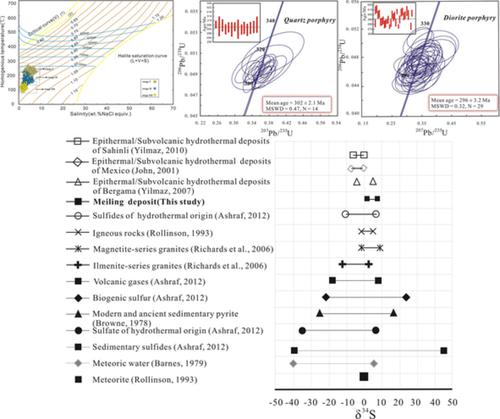当前位置:
X-MOL 学术
›
Geolog. J.
›
论文详情
Our official English website, www.x-mol.net, welcomes your
feedback! (Note: you will need to create a separate account there.)
Fluid evolution and metallogenesis of the Meiling Cu‐polymetallic deposit in the East Tianshan, NW China: Constraints from ore geology, fluid inclusions, stable isotope, and U–Pb geochronology
Geological Journal ( IF 1.4 ) Pub Date : 2020-11-23 , DOI: 10.1002/gj.4038 Xihui Cheng 1, 2 , Fuquan Yang 2 , Rui Zhang 3 , Zhixin Zhang 4 , Ning Li 2 , Chengdong Yang 2
Geological Journal ( IF 1.4 ) Pub Date : 2020-11-23 , DOI: 10.1002/gj.4038 Xihui Cheng 1, 2 , Fuquan Yang 2 , Rui Zhang 3 , Zhixin Zhang 4 , Ning Li 2 , Chengdong Yang 2
Affiliation

|
The Meiling Cu‐polymetallic deposit is located in the Kalatag Cu metallogenic belt of the East Tianshan, Xinjiang, NW China. Multiple‐stage hydrothermal activities have resulted in the silicification, chlorite alteration and sericite alteration in this deposit. At least three mineralization stages are recorded: (a) a phase comprising quartz–pyrite veining, (b) a quartz–chalcopyrite–pyrite–sphalerite phase and (c) a quartz–calcite phase, respectively. LA–ICP–MS zircon U–Pb dating yielded 302 ± 2.1 Ma for an ore‐bearing quartz porphyry and 296 ± 3.2 Ma for a post‐mineralization diorite porphyry dyke, respectively, indicating that the copper mineralization took place during the Late Carboniferous period (302–296 Ma). Fluid evolution during the three stages of mineralization was determined by a detailed fluid inclusion study: (a) Stage I fluids were trapped under two‐phase conditions, as evidenced by the coexistence of vapour‐rich (type II) inclusions (Th = 183–242°C, average salinity = 4.8 wt% NaCl equiv.), liquid‐rich (type I) inclusions (Th = 171–259°C, average salinity = 5.3 wt% NaCl equiv.), and daughter‐bearing (type III) inclusions (Th = 192–208°C, average salinity = 8.6 wt% NaCl equiv.). (b) Stage II fluid inclusions in quartz were also trapped under two‐phase conditions (boiling), as identified by the coexistence of V‐ and L‐type fluid inclusions; L‐type inclusions Th between 136 and 218°C (average = 189°C), with salinities of 2.2–7.6 wt% NaCl equiv. (average = 3.8 wt% NaCl equiv.). V‐type inclusions homogenized temperatures between 153 and 226°C (average = 192°C), with salinities of 2.4–6.7 wt% NaCl equiv. (average = 3.5 wt% NaCl equiv.). (c) Stage III fluids are represented by inclusions in barren quartz–carbonate veinlets, characterized by homogenization temperatures ranging from 98 to 177°C (average = 135°C) and salinities between 0.5 and 3.2 wt% NaCl equiv. (average = 1.9 wt% NaCl equiv.). The initial hydrothermal fluids are characterized by low–intermediate temperature, low‐salinity and near‐neutral pH condition, belonging to a H2O–NaCl bearing hydrothermal system. The mineralization of the Meiling deposit occurred at a shallow crustal level (~0.5 km), and the decrease of temperature was likely an important factor responsible for metal accumulation and deposition in the subvolcanic hydrothermal system.
更新日期:2020-11-23











































 京公网安备 11010802027423号
京公网安备 11010802027423号